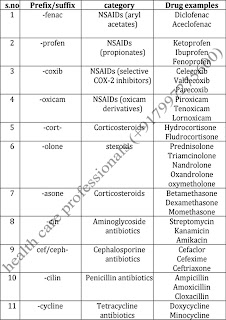Are you tired of struggling to memorize countless drug names, classifications, and actions? Look no further! Our tailored drug memorization tips are designed to make learning pharmacology a breeze. Here's what sets our approach apart:
Mnemonic Devices: We've crafted memorable mnemonic devices tailored to each drug or drug class, making it easy to recall even the most complex names and mechanisms of action. Say goodbye to rote memorization and hello to effortless recall!
Visual Aids: Harnessing the power of visualization, our tips incorporate vivid imagery and associations to cement drug information in your memory. Whether it's picturing a specific shape or color associated with a drug, our visual aids transform abstract concepts into tangible memories.
Association Techniques: By linking drugs to familiar concepts or everyday experiences, we facilitate seamless integration of drug knowledge into your existing mental framework. From relating drug actions to common household items to associating drug names with famous personalities, our association techniques ensure retention through relevance.
Interactive Learning: Engage multiple senses through interactive learning activities such as flashcards, quizzes, and games. Our hands-on approach transforms passive memorization into an immersive learning experience, fostering deeper understanding and retention.
Customizable Strategies: Recognizing that every learner is unique, our tips offer flexibility to adapt to your individual learning style and preferences. Whether you're a visual learner, an auditory learner, or a kinesthetic learner, our strategies can be tailored to suit your needs.
With our proven drug memorization tips, mastering pharmacology has never been easier. Say goodbye to overwhelming study sessions and hello to confident, efficient learning. Try our tips today and unlock the secrets to drug memorization success!
I have provided the list of some major drug classes at the end.
Drug classifications can be extensive, as they categorize medications based on their chemical characteristics, therapeutic effects, and mechanisms of action. Here is a comprehensive list of major drug classifications:
1. Analgesics:
- Opioid analgesics (e.g., morphine, oxycodone)
- Non-opioid analgesics (e.g., acetaminophen)
- Nonsteroidal anti-inflammatory drugs (NSAIDs) (e.g., ibuprofen, naproxen)
2. Antibiotics:
- Penicillins (e.g., amoxicillin)
- Cephalosporins (e.g., ceftriaxone)
- Macrolides (e.g., azithromycin)
- Tetracyclines (e.g., doxycycline)
- Aminoglycosides (e.g., gentamicin)
- Fluoroquinolones (e.g., ciprofloxacin)
3. Antifungals:
- Azoles (e.g., fluconazole)
- Echinocandins (e.g., caspofungin)
- Polyenes (e.g., amphotericin B)
4. Antivirals:
- Anti-HIV drugs (e.g., zidovudine)
- Anti-influenza drugs (e.g., oseltamivir)
- Anti-hepatitis drugs (e.g., sofosbuvir)
5. Antidepressants:
- Selective serotonin reuptake inhibitors (SSRIs) (e.g., fluoxetine)
- Serotonin-norepinephrine reuptake inhibitors (SNRIs) (e.g., venlafaxine)
- Tricyclic antidepressants (TCAs) (e.g., amitriptyline)
- Monoamine oxidase inhibitors (MAOIs) (e.g., phenelzine)
6. Antipsychotics:
- Typical antipsychotics (e.g., haloperidol)
- Atypical antipsychotics (e.g., risperidone)
7. Anxiolytics:
- Benzodiazepines (e.g., diazepam)
- Non-benzodiazepines (e.g., buspirone)
8. Anticonvulsants: (e.g., phenytoin, valproate)
9. Antihypertensives:
- ACE inhibitors (e.g., lisinopril)
- Beta-blockers (e.g., metoprolol)
- Calcium channel blockers (e.g., amlodipine)
- Diuretics (e.g., furosemide)
10. Antiarrhythmics: (e.g., amiodarone, digoxin)
11. Hypoglycemic agents:
- Insulins (e.g., insulin glargine)
- Oral hypoglycemics (e.g., metformin, sulfonylureas)
12. Hypolipedimic agents:
- Statins (e.g., atorvastatin)
- Fibrates (e.g., fenofibrate)
13. Diuretics:
- Thiazide diuretics (e.g., hydrochlorothiazide)
- Loop diuretics (e.g., furosemide)
- Potassium-sparing diuretics (e.g., spironolactone)
14. Gastrointestinal drugs:
- Proton pump inhibitors (e.g., omeprazole)
- H2 receptor antagonists (e.g., ranitidine)
- Antacids (e.g., aluminum hydroxide)
15. Hormonal agents:
- Corticosteroids (e.g., prednisone)
- Estrogens (e.g., estradiol)
- Androgens (e.g., testosterone)
- Thyroid hormones (e.g., levothyroxine)
Based on Mechanism of Action
1. Enzyme Inhibitors:
- ACE inhibitors
- HMG-CoA reductase inhibitors (statins)
2. Receptor Blockers:
- Beta-blockers
- Alpha-blockers (e.g., doxazosin)
3. Ion Channel Modulators:
- Calcium channel blockers
- Sodium channel blockers (e.g., lidocaine)
4. Neurotransmitter Modulators:
- SSRIs
- Dopamine agonists (e.g., pramipexole)
Based on Chemical Structure
1. Alkaloids (e.g., morphine, quinine)
2. Steroids (e.g., prednisone, estrogen)
3. Peptides and Proteins (e.g., insulin, erythropoietin)
4. Nucleotides and Nucleosides (e.g., acyclovir)
Based on Legal Classification
1. Prescription Drugs
2. Over-the-Counter (OTC) Drugs
3. Controlled Substances (e.g., Schedule I-V drugs in the U.S.)
Other Classifications
1. Vaccines
2. Biologics
3. Radiopharmaceuticals
4. Herbal Supplements
5. Nutraceuticals
This list provides an overview, but drug classifications can vary and overlap depending on context and specific uses.










.webp)

0 Comments